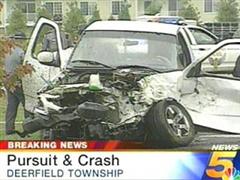|
||||||||||||
The appeal of “World’s Wildest Police Videos” rests in part, to the aesthetic pleasure and appeal of programming which is reality-based, and carefully packaged. Crime-based television dramas or action films spread the excitement out over an hour or two, filling the time between each car crash or shoot out with potentially boring material as character development, or romantic subplots. “WWPV” pounds out one wild vignette after another, each quickly escalating to an exciting and entertaining climax. The show features car chases, car crashes, police chasing suspects with guns drawn, and intoxicated drivers begging to not be arrested. As soon as one suspect is handcuffed, viewers are treated to the screaming sirens, and flashing lights leading to the next thrilling segment. All of this excitement comes at a fraction of the cost of producing an hour-long drama, as main characters are likely never paid for their participation and generally have little or no training before taping begins.
The scarcity of truly wild footage forces the producers to maximize the excitement of what they do have. Through imaginative narration and careful editing, mundane video scenes can be transformed into spectacles of conflict between dangerous criminals and well-trained officers. For example, a grainy image of a drunken suspect swinging at an officer becomes the climax of an elaborate story about an idiotically defiant criminal and a fast-acting police officer whose actions protect decent, law abiding citizens. In another segment the Sherriff Bunnell describes two shoplifters fleeing in a pick up truck as “terrorizing the streets” and threatening the lives of everyone around them. The narration and editing are so effective at creating a spectacular story out of initially blurry and shaky images that even nearby wildlife can be transformed into dangerous criminals. In one case, even a runaway horse is described as a hooligan defying police authority. There are two narrative perspectives often employed in the “Worlds Wildest” series. In addition to enhancing the excitement of the videos, the narration justifies an ever widening range of police conduct. The first is Bunnell’s omnipotent, and exaggerated voice-over. This narration provides the viewers with information about the criminal featured in a given segment that the officers did not know at the time. When an officer has stopped a suspect over for an unspecified or vague traffic offense such as the classic “suspicious driving”; Bunnell explains that the suspect has a warrant out for his or her arrest, is mentally ill, or has just committed a robbery. While this information was likely unknown to the officer when he or she made the decision to pull the suspect over, the narration confirms the officer’s suspicions thereby justifying the traffic stop. Scenes such as this lend themselves to additional elaboration as to the bravery, skill, and supposed intelligence of said police officers. The second type of narration is disguised as a police officer or helicopter pilot’s comments. Bunnell does not inform the audience as to who is speaking in these segments and there is no other identification of them. If one listens carefully, the same voice is frequently used for the helicopter pilot or officer speaking over the radio in most of the applicable segments. This narration attempts to portray a sense of authenticity by mimicking the types of distorted voices that one would hear in a breaking news report. These voices speak as though the narrated events were unfolding in real time, again providing viewers with information that was most likely not known to officers at the time, yet provided in such a way as to enhance the dramatic effect.
Boys will be Boys!
White Trash
SiteMap
gallery
Support Our Troops
Redneck Politics
©bsornot.whipnet.net 2005-2016 |



